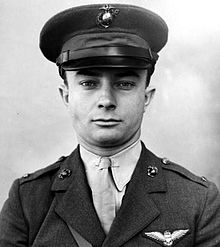Frederick R. Payne Jr.
Frederick "Fritz" Rounsville Payne Junior (born July 31, 1911 in Elmira , New York ; † August 6, 2015 in Rancho Mirage , California ) was an American brigadier general in the US Marine Corps and at the time of his death the oldest of the so-called aviator aces of the Second World War . For his military services in World War II, he was awarded the Navy Cross and the Distinguished Flying Cross in 1942 . For his services during the Korean War , he was also awarded the Legion of Merit in 1952 . In 2015 he was awarded the Congress Gold Medal of Honor .
Life
Naval aviators and World War II
Payne, whose father had participated as an officer in the US Navy in the Spanish-American War in 1898 , began his training at the US Naval Academy in Annapolis after attending the Culver Military Academy in Indiana in 1932 , which he graduated in 1934. After studying at the University of Arizona , he joined the US Marine Corps in 1935.
A day after the attack by the Imperial Japanese Navy Air Force on Pearl Harbor on 7 December 1941 stood Paynes naval aviation unit on the aircraft carrier USS Saratoga to sea to at the Battle of Guam participate. Within a year he flew into the elite ranks of the American Aces , a group of fighter pilots who shot down at least five enemy planes.
His main merits lay in the Battle of Guadalcanal , when the island of Guadalcanal and the Solomon Islands were under constant fire during the Pacific War , so that the ground troops of the US forces stationed there were considerably weakened in the jungle fighting that took place next to it. Major Payne flew numerous missions as a pilot of Marine Fighting Squadron 212 (VMF-212) during this time . This belonged to Marine Air Group 23 (MAG-23) of the 1st Marine Aircraft Wing . He shot down a total of six enemy Japanese aircraft in twenty missions between September 13 and 15, 1942. Officially, 5.5 kills were attributed to him, as another US Navy pilot was involved in one kill. In the following years he took part in other missions to control the airspace over the islands. Due to malaria he suffered a faint attack during a mission and was able to prevent his crash at the last moment by making an emergency landing .
Because of the heroic and extraordinary achievements during his missions, he was first awarded the Distinguished Flying Cross in 1942. In addition to the Battle of Guadalcanal, Payne also took part in the battles around Kwajalein and Hollandia and was promoted to lieutenant colonel in 1943 . On November 20, 1943, he was finally awarded the Navy Cross, the highest honor awarded by the Department of the Navy .
Korean War, Brigadier General and Private Business
During the Korean War Payne February 29, 1952, until March 20, 1952, first deputy commander ( Executive Officer ) and then from March 21 to May 18, 1952 Commander ( Commanding Officer ) of Naval Air Monitoring Group (Marine Air Control Group) before he then found between May 19 and September 29, 1952 use as a liaison officer of the 1st Marine Aircraft Wing to the 5th Air Force ( Fifth Air Force ) of the Pacific Air Forces . He was awarded the Legion of Merit for his services during the Korean War . In 1958 he retired as a Brigadier General from active military service in the US Marine Corps.
Payne then began a job with the electricity company Southern California Edison , for which he set up a helicopter department to build and monitor the high-voltage lines operated by this company . He was also involved in the construction of the San Onofre nuclear power plant , which was commissioned in 1968. In 1976 he retired.
In May 2015, the 1,442 living and deceased aces in were Washington, DC with the Golden Medal of Honor of the Congress (Congressional Gold Medal) awarded, in addition to the peer Presidential Medal of Freedom one of the two highest civilian awards in the United States and by both houses by the United States Congress , the Senate, and the House of Representatives . Payne, like most of the 71 living pilots, was unable to attend this ceremony due to his health. Instead, he was presented with the award on May 25, 2015 as part of Memorial Day celebrations at the Palm Springs Air Museum .
Payne died of old age three months later on August 6, 2015, a week after his birthday at the age of 104, making it the oldest living flying ace of World War II, according to the Seattle- based American Fighter Aces Association . From his marriage to his wife Dorothy Payne, who died in 2011, the sons Robert Payne and Dewitt Payne and the daughter Elizabeth Ann Payne were born.
Web links
- Steve Chawkins: Brig. Gen. Frederick Payne Jr. dies at 104; Navy fighter ace in WWII. In: Los Angeles Times of August 12, 2012 (English)
- Sam Roberts: Frederick Payne, Decorated Fighter Ace, Dies at 104. In: The New York Times, August 20, 2015 (English)
- Entry in the Hall of Valor of the Military Times (English)
| personal data | |
|---|---|
| SURNAME | Payne, Frederick R. Jr. |
| ALTERNATIVE NAMES | Payne, Frederick Rounsville Payne Junior (full name); Payne, Fritz (nickname) |
| BRIEF DESCRIPTION | American Brigadier General in the US Marine Corps |
| DATE OF BIRTH | July 31, 1911 |
| PLACE OF BIRTH | Elmira , New York |
| DATE OF DEATH | August 6, 2015 |
| Place of death | Rancho Mirage , California |
